In our last few blog posts, we’ve talked about customer segmentation and different ways to segment your target audience into smaller chunks like demographic and psychographic segmentation to connect with the right people. Customer segmentation enables marketers to focus their marketing efforts on their target customers, improving their marketing targeting strategy.
But what if there was a subset of users that had an even bigger impact when targeted? Enter Super Users – the strategic players who can give your ROI numbers a major boost! It may take some trial-and-error testing to pinpoint these super segments accurately, but knowing how these key individuals interact is essential for any successful marketing targeting strategy.
What is a Super User?
As technology progresses and media consumption grows, a unique group is rising to the top.
Activate Consulting’s Technology & Media Outlook 2023 found that Super Users are powering the digital world, with a strong presence across all major media and technology verticals. This select crowd is made up of young, educated individuals who lead affluent lifestyles – spending more time and money than any other user group!
Why should you add Super Users to your marketing targeting strategy?
Super Users are a highly influential audience with the potential to drive major business growth. They stand out from other users in their commitment and dedication across four key areas:
- Time spent with media
- Spend
- Technology and media adoption
- Emerging eCommerce behaviors
“Over the next years, the imperative for technology and media companies will be to identify, reach, and super-serve Super Users – the single group of power users whose time and spend far surpass those of other users.”
Activate consulting’s technology & media outlook 2023
You can use Super Users as a subset of your marketing targeting strategy. While you may need to reach beyond Super Users to achieve your goals, it’s worthwhile to consider:
- Targeting them separately
- Spending more on media
- Reaching them at a higher frequency
Time spent with media
Super Users make a powerful impact, despite comprising only 22% of the U.S. population. They are incredibly influential in terms of media consumption and engagement – spending more than double the amount of time interacting with content compared to other users.
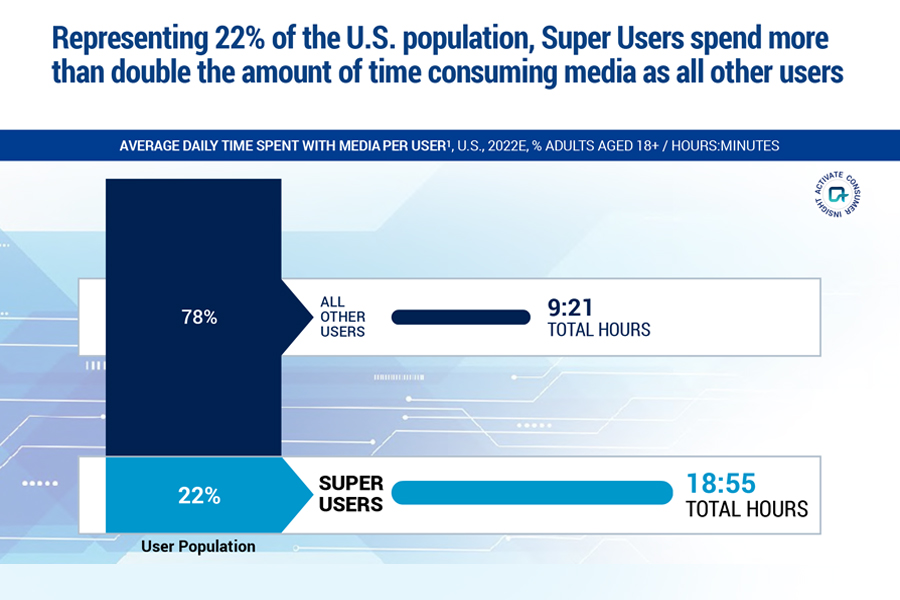
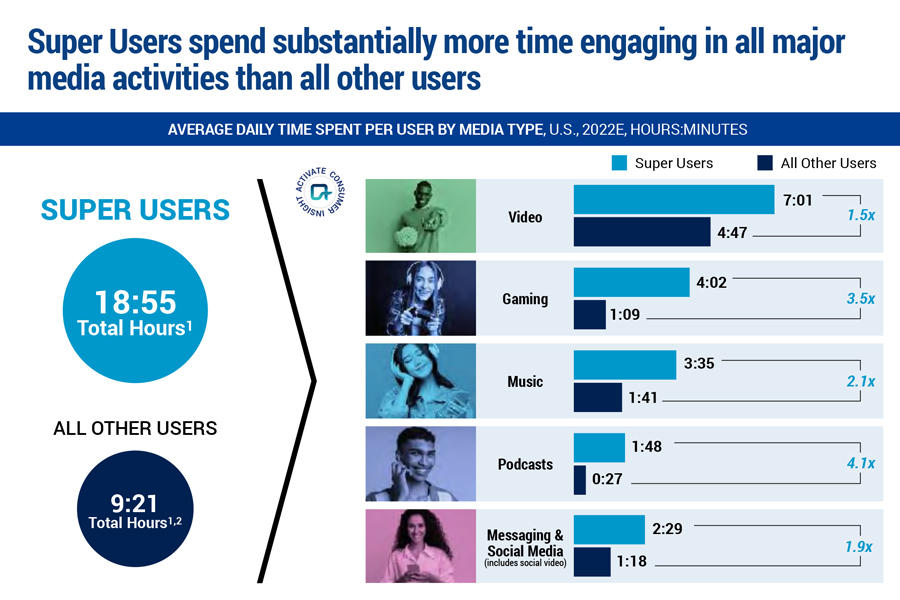
Inclined to multitask
Super Users take multitasking to the next level. Not only do they spend more time with electronics, but they excel in the art of juggling multiple activities. While watching videos and playing video games on one device, Super Users might also be busy engaging with social media on another. This makes them an unstoppable force when it comes to getting the most out of their digital experiences!

High share of dollar spend
Super Users are big spenders when it comes to media, particularly in gaming and music. Compared with all other users, Super Users’ average video spend is close to triple the amount ($76 vs $27). However, their biggest increases come from gaming and music; they’re collectively spending 12x more on games and shelling out 21x as much for tunes!
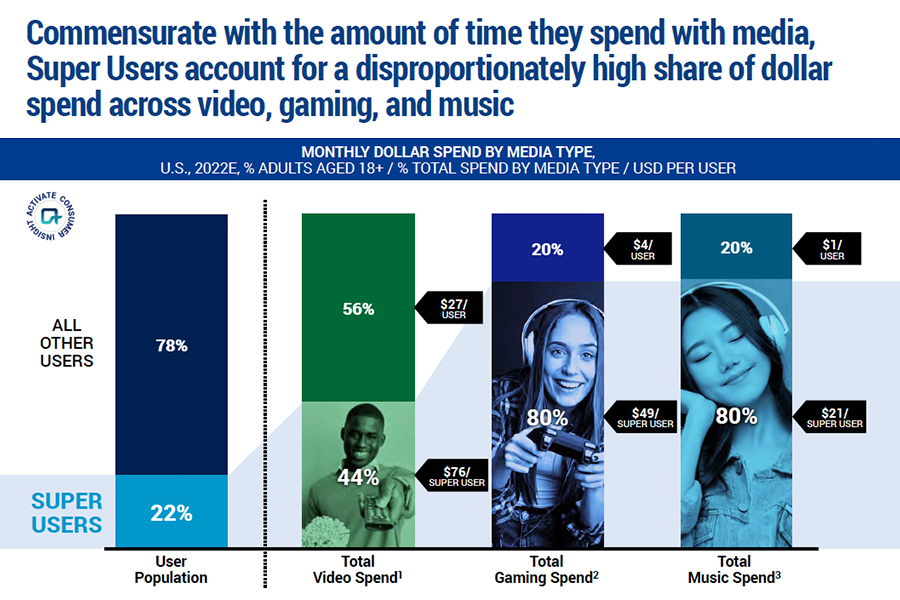
With 60% of eCommerce spend coming from Super Users, they are driving the industry forward with their enthusiasm and willingness to test out cutting-edge shopping trends like buying through social media, live streaming purchases, and trying on products virtually. Super Users are setting the tone for this dynamic industry.
Technology and media adoption
Most Super Users are brand advocates. They’re trendsetting individuals who stay ahead of the curve on media and technology. They eagerly take advantage of new products, services, and data-sharing opportunities to receive tailored ads that fit their lifestyle.
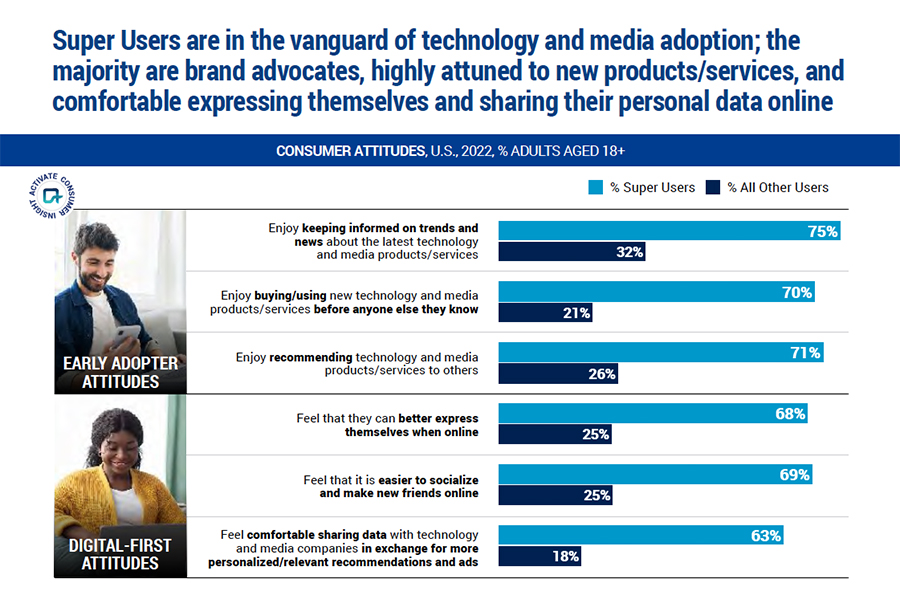
Crypto & NFTs
Super Users blaze the trail for cryptocurrency and non-fungible tokens (NFTs)! This group is five times more likely to explore, engage with, and embrace new digital-monetary technologies.
Pioneers of the Metaverse
As Metaverse usage continues to rise, Super Users are leading the way. Over 80% of these trailblazers have embraced these digital spaces within just the last year. We’re seeing accelerated interest from them as they seek out new opportunities for creativity, connections, and transactions within their favorite Metaverses. Many express interest in Metaverse experiences such as purchasing physical items to creating virtual havens. In fact, they’re 5x more interested in all things meta-related!
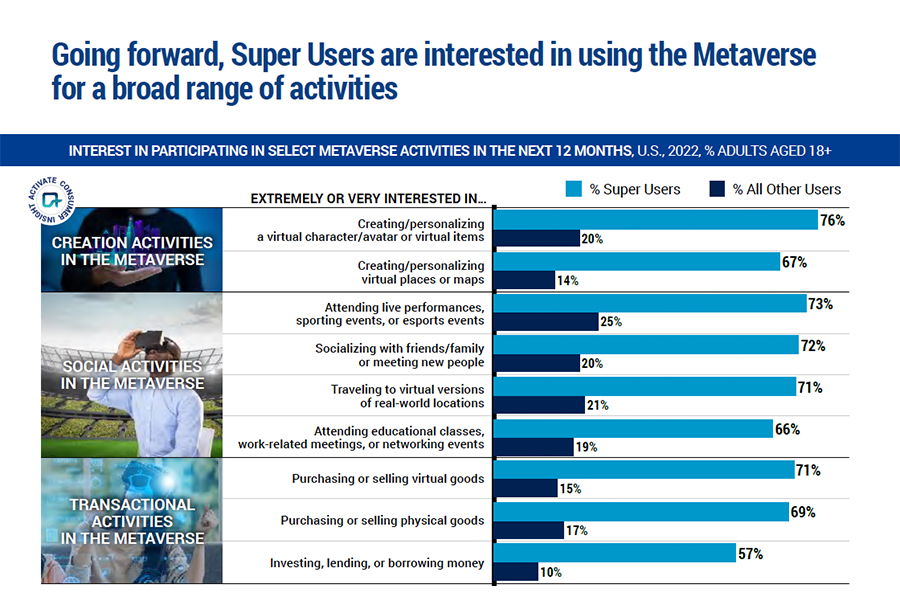
How Experian can help you identify and target Super Users
So how can you find your Super Users and include them in your marketing targeting strategy? Whether you want to build or acquire highly addressable audiences, we can help you precisely reach the right individuals and households in any channel you desire with Consumer View.
Consumer View
It all starts with data. Delivering the right message in the right place at the right time means truly knowing your prospects and customers as individuals – their lifestyles, behaviors, and shopping preferences. Consumer View data can provide a deeper understanding of your customers.
Consumer View is the world’s largest consumer database that contains over 3,900 attributes for 250 million adult consumers in the U.S. with coverage of 126 million (98%) of U.S. households. Consumer View can help you find out:
- What do your customers look like?
- What do your customers do?
- How and when should you reach your customers?
- What motivates your customers?
Modeled and syndicated audiences
We have over 2,500 pre-built audiences that are privacy-safe and built using advanced data science and the most comprehensive consumer data available. These digital audiences are readily available via major publishers, data management platforms (DMPs), advanced TV operators, and demand-side platforms (DSPs).
Our pre-built audiences can be used consistently across multiple distribution partners – making sure you can quickly find the right audience for the right campaign without having to build your own consumer personas. In addition to being available as digital audiences, our segmentation products are also available to use across all consumer touchpoints to enable consistent omnichannel campaign targeting.
There are infinite data combinations and selections we can help you with for optimal audience targeting. Using our comprehensive inventory of data, we can find even the most unusual of audiences to help you connect with new prospects. From demographics to behavioral and psychographic information, we draw on a massive base of knowledge accumulated during five decades in business.
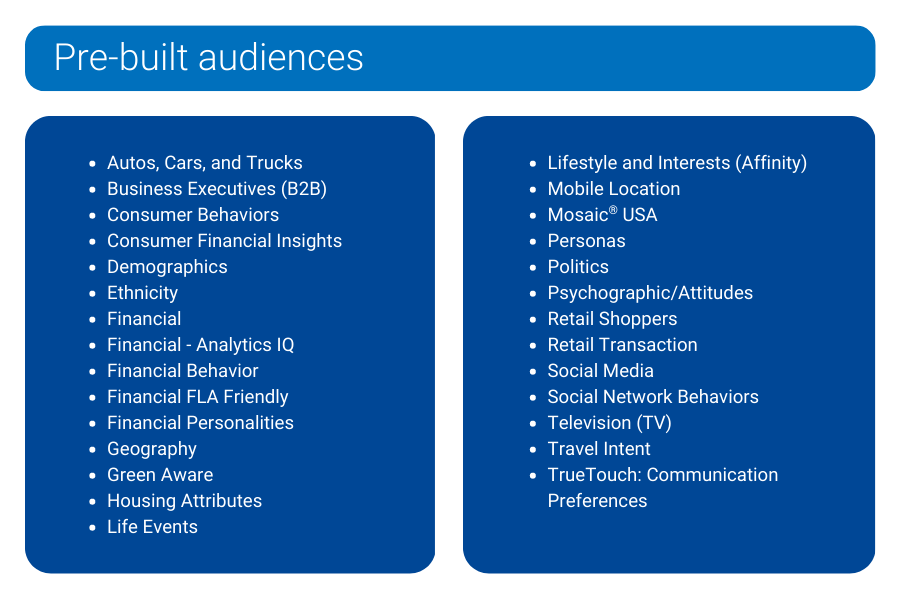
Mosaic® USA
Experian’s Mosaic® USA is a household-based consumer lifestyle segmentation system that classifies all U.S. households and neighborhoods into 71 unique types and 19 overarching groups, providing a 360-degree view of consumers’ choices, preferences, and habits. Using Mosaic lifestyle segmentation, you can anticipate the behavior, attitudes, and preferences of your best customers and reach them in the most effective traditional and digital channels with the right message in the right place at the right time.
Tailored Segmentation uses a sophisticated data-driven clustering system that leverages the 71 Mosaic types that match to first-party data like yours. Tailored Segmentation allows you to regroup Mosaic types based on the attributes you weigh as more impactful to your business. Have you designed your own segments in-house? You can apply Tailored Segmentation to those segments for deeper insights through a tailored analysis. Are you still looking for a way to segment your market even though you understand your typical best customer? Tailored Segmentation can weigh these attributes and develop a custom clustering and analysis of your market.
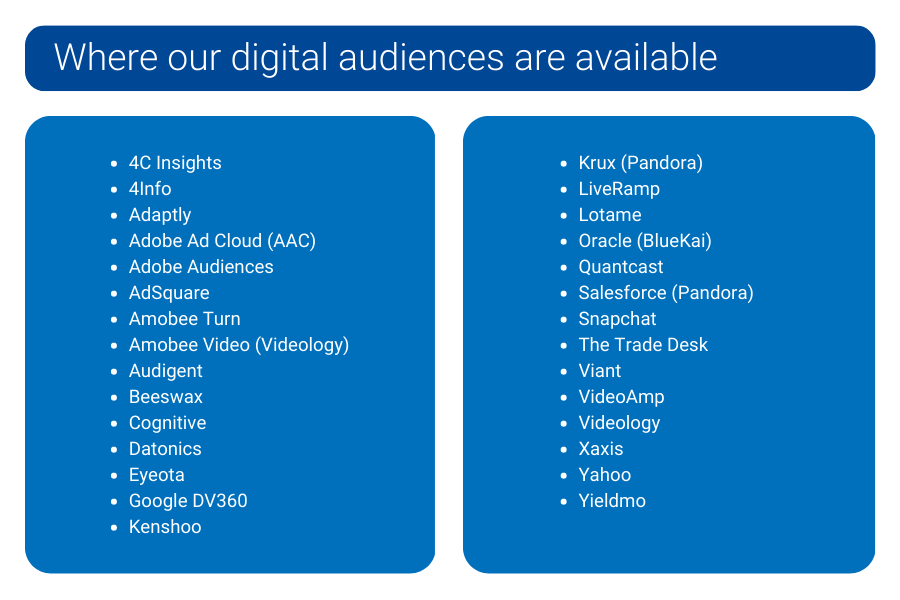
We can help you find your Super Users
Super Users are an important segment of any market. Marketers need to be able to identify them quickly and act upon their insights. Our marketing solutions provide the necessary data and analytical capabilities to easily find and target your potential Super Users for an effective marketing targeting strategy.
With Experian, you can deliver messages that are more in line with what matters to this influential group of customers. We understand how challenging it can be to find these customers and ensure they get the tailored, personalized messaging they deserve – so let us help you do just that! We can provide deep insights beyond the generic customer persona that allows marketers to look into the effectiveness of their marketing strategies from multiple angles. We want to help you gain an edge over your competitors by helping you identify, target, and engage Super Users for increased revenue growth. Ready to find your Super Users?
Sources
Activate Technology & Media Outlook 2023. Activate Consulting.
Latest posts

Study reveals that brands with more mature identity programs were significantly more likely to be successful in achieving their key objectives Tapad, a part of Experian, a global leader in cross-device digital identity resolution and a part of Experian, has commissioned Forrester Consulting, part of a leading research and advisory firm, to conduct a new study that evaluates the current state of customer data-driven marketing and explores how marketers can use identity solutions to deliver privacy safe and engaging experiences, in an evolving data landscape. The study highlights the changing ground rules for digital marketing and the threat that poses to marketers’ ability to deliver against long standing KPIs and campaign goals. Nearly two-thirds (62%) of respondents said that the forces of data deprecation will have a significant (40%) or critical (21%) impact on their marketing strategies over the next two years. Among those surveyed, identity resolution strategies have surfaced as an opportunity to create more powerful customer experiences, with 66% aiming to have it help improve customer trust and implement more ethical data collection and use practices, while nearly 60% believe it will point the way to more effective personalization and data management practices. Although organizations are eager to implement identity resolution strategies, a complex web of solutions and partners makes execution a challenge. For example, respondents report using at least eight identity solutions on average, across nearly six vendor partners, and they expect that fragmentation to persist in the ‘cookieless’ future. Additionally, brands’ identity resolution technologies typically represent a patchwork of homegrown and commercial solutions. Eighty-one percent of respondents use both in-house and commercial identity resolution tools today, and 47% use a near-equal blend of the two. Despite the challenges, many brands have the foundation for a strong identity resolution strategy in place, and they are thriving as a result. Specifically, more mature brands were 79% more successful at improving privacy safeguards to reduce regulatory and compliance risk, 247% more successful at improving marketing ROI, and over four times more effective at improving customer trust compared to their low-maturity peers. Additional insights include: Marketers Are Increasingly Playing a Key Strategic Role Within the Organization, But There is a Mandate to Demonstrate Value. Nearly three-quarters of respondents in our study agree the marketing function is more strategically important to their organization than it used to be, while almost two-thirds agree there’s more pressure than ever to prove the ROI or business performance of their activities. Consumers Expect Brands to Deliver Engaging Experiences Across Highly Fragmented Journeys: Tapad, a part of Experian found that 72% of respondents agree that customers demand more relevant, personalized experiences at the time and place of their choosing. At the same time, 67% of respondents recognize that customer purchase journeys take place over more touchpoints and channels than ever, and 59% of respondents agree that those journeys are less predictable and linear than they once were. Marketing Runs on Data, But the Rules Governing Customer Data Usage are Ever-Evolving: According to the study, 70% of decision-makers agree that consumer data is the lifeblood of their marketing strategies – fueling the personalized, omnichannel experiences customers demand. At the same time, 69% of respondents recognize that customers are increasingly aware of how their data is being used. At least two-thirds agree that data deprecation, including tighter restrictions on data use (66%), as well as operating system and browser changes impacting third-party cookies (68%) means that legacy marketing strategies are unlikely to remain viable in the long-term.“ Our latest survey findings give us a better understanding of how our customers and other companies around the world are trying to master the relationship between people, their data and their devices,” said Mark Connon, General Manager at Tapad, a part of Experian. “This research shows why it's fundamental for the industry to continuously work to develop solutions that are agnostic. Tapad, a part of Experian has worked tirelessly to deliver on this with our Tapad Graph, and by introducing solutions like Switchboard to help the evolving ecosystem and in turn helping customers reap the benefits of better identity in both short and long-term.” The study is founded on an online survey of over 300 decision-makers at global brands and agencies, which was fielded from March to April, 2021. Data deprecation and identity are fast-developing, moving targets, so this study delivers targeted insights and recommendations for how to prepare for coming shifts in customer data strategies – whether they manifest tomorrow or a year from now. Get started with The Tapad Graph For personalized consultation on the value and benefits of The Tapad Graph for your business, email Sales@tapad.com today!

Marketers are always challenged to expand sales beyond “business as usual,” while being good stewards of company resources spent on marketing. Every additional dollar spent on marketing is expected to yield incremental earnings—or else that dollar is better spent elsewhere. You must be able to determine return on advertising spend (ROAS) for any campaign or platform you add to your marketing mix. A key driver of positive ROAS is incremental customer actions produced by ad exposure. Confident, accurate measurement of incremental actions is the goal of an effective testing program. Why do we test campaign performance? Because demonstrating incremental actions from a campaign is a victory. You can keep winning by doing more of the same. Not finding sufficient incremental actions is an opportunity to reallocate resources and consider new tactics. Uncertainty whether the campaign produced incremental actions is frustrating. Ending a profitable marketing program because incremental actions were not effectively measured is tragic. Test for success When you apply rigorous methods to test the performance of campaigns, you can learn to make incremental improvements in campaign performance. The design of a marketing test requires the following: Customer Action to be measured during the test. This action indicates a recognizable step on the path to purchase: awareness, evaluation, inquiry, comparison of offers or products, or a purchase. Treatment, i.e., exposure to a brand’s ad during a campaign. Prediction regarding the relationship between action and treatment (e.g., Ad exposure produces an increase in purchase likelihood). Experimental design is the structure you will create within your marketing campaign to carry out the test. Review of results and insights. Selecting a customer action to measure Make sure that the customer action you measure in your test is: Meaningful to the campaign’s goal. What is the primary goal of the campaign? Is it brand awareness? Web site visits? Inquiries? Completed sales? An engagement by the customer. Your measurement should capture meaningful, deliberate interaction of consumers with the brand. Attributable to advertising. There should be a reasonable expectation that ad exposure should increase, or perhaps influence the nature of customer actions. Abundant in the data. Customer action should be a) plentiful and b) have a high probability of being recorded during the ad campaign (in other words, a high match rate between actions and the audience members). Selecting campaign treatments It is best for treatments to be as specific as possible. Ad exposures should be comparable with respect to: brand and offer, messaging, call to action, and format. Making a prediction This is the “hypothesis.” Generally, you assume that exposure to advertising will influence customer actions. To do this, you need to reject the conclusion that exposure does NOT affect actions (the “null hypothesis”). Elements of an experimental design An attribution method that links each audience to their purchase action during the test. This consists of a unique identifier of the prospect which can be recognized both in records of the audience and records of the measured action during the measurement period. A target audience that receives ad exposure. A control audience that does not receive ad exposure. It provides a crucial baseline measurement of action against which the target audience is compared. Time boundaries for measurement, related to the treatment: Pre-campaign Campaign Post-campaign Randomly selected audiences (recommended) Some audience platforms, such as direct mail and addressable television operators, feature the ability to select distinct audience members in advance. Randomly selected audiences can generally be assumed to be similar in all respects except ad exposure. The lift of the action rate is simple to calculate: Campaign Lift = (Action Rate (target) / Action Rate (control)) -1 Non-randomly selected audiences are more difficult, but still possible, to measure effectively. There may be inherent biases between them that may or may not be obvious. To measure campaign performance, we must first account for any pre-existing differences in customer actions, and then adjust for these when measuring the effect of ad exposure. Typically, the pre-campaign period (and possibly the post-campaign period as well) are used to obtain a baseline comparison of actions between the two audiences. This is a “difference of differences” measurement: Baseline lift = (Action Rate (target) / Action Rate (control)) -1 Campaign Lift = (Action Rate (target) / Action Rate (control)) -1 Net campaign lift (advertising effect) = Campaign Lift – Baseline Lift Analyzing results and insights How large is the lift? This is generally expressed as a percentage increase in action rate for the target audience vs. the control audience. Are we confident that the lift is real, and not just random noise in the data? This question is answered with the “confidence level.”. 95% confidence means the probability of a “true positive” result is 95%; and the probability of a “false positive” due to random error is 5%. What was the campaign cost per incremental action? If you also know the expected revenue from each incremental action, you can project out incremental revenue, from which you can calculate return on ad spend. Other insights: Do the results make directional sense (we would hope that ad exposure will cause an increase in customer actions, not a decrease)? Does action rate generally increase with the number of ad exposures? Summary Well-designed testing and measurement practices allow you to learn from individual advertising campaigns to improve decision-making. The ability to draw confident conclusions from campaigns will allow experimentation with different strategies, tactics, and communication channels to maximize performance. These test-and-learn strategies also enhance your ability to adjust to marketplace trends by monitoring campaign performance. To learn how Experian’s solutions can help you measure the success of your marketing campaigns, watch our short video, or explore our measurement solutions.

It’s almost that time of the year again, the time to put away fourth of July merchandise and replace it with this year's favorite superhero backpacks. It’s almost back-to-school season, and parents and kids from kindergarten to college are preparing for school's "new normal." To navigate the challenge of 2021, Experian’s Marketing Analytics team is sharing Back-to-School shopping season insights with you. Download the eBook to learn more. Our outlook about this year's Back-to-School shopping season can help you better plan and improve your marketing effectiveness. The report covers who's actively shopping for school supplies, whether they're shopping in-person or online, and what they're buying this year. Here's a summary of what you'll learn in the report: Who (specifically) is shopping for back-to-school supplies this year? More than half of online searches related to Back-to-School were made by a small set of consumer segments. We’ve identified 4 Mosaic® groups as being in-market for back-to-school merchandise. To find these types of consumers, we used online behavioral data and filtered for households with school-age children between 5 and 15 years old. Each group, such as Flourishing Families, share similar shopping behaviors and needs. While each group of consumers has a need for Back-to-School merchandise, they have different circumstances that require more personalized marketing. Let's break down each Mosaic® group to better understand their size and key features so that you can build more personalized messaging. Contact us for segments and insights specific to your brand. Power Elite As you can see in our Mosaic® product brochure, Power Elite is categorized as Group A. This is the largest group analyzed in the report, accounting for 4.5 million U.S. households. Here are the Power Elite consumer types actively shopping for back-to-school merchandise this year: A01: American Royalty A03: Kids and Cabernet A04: Picture Perfect Families Key Features: Wealthy Highly Educated Politically conservative Purchase housewares and electronics in store Vacation and fitness retail influencers Luxury lease cars Flourishing Families Also called Group B in this report, Flourishing Families is comprised of 3.7 million U.S. households. Active consumer types: B07: Across the Ages B08: Babies and Bliss B09: Family Fun-tastic Key Features: Affluent Charitable contributors Athletic activities High-priced children’s clothing Home products & furnishings Sporting good Suburban Style Suburban Style, also Group D, is made up of 2.9 million U.S. households. Active consumer types: D15: Sport Utility Families D16: Settled in Suburbia Key Features: Comfortable lifestyle Ethnically diverse Politically diverse Instagrammers Children’s games Wholesale members Family Union The Family Union group, Group I, is the smallest of those analyzed in this report, but still a respectable size: 1.2 million U.S. households. Active consumer types: I31: Hard Working Values Key Features: Bilingual Married with kids Large households Hunting clothing Automotive tools Will they shop online or in stores? Prepare for a return to in-store shopping as the US moves post-pandemic. These consumers have shopped in-store for Back-to-School and have trended toward in-store shopping as the vaccine was distributed. Mobile location data shows these consumers actively shopped in-person during the 2019 Back-to-School season, and are shopping in-person again post-pandemic. Experian analyzed consumer mobile location data for big box retailers, department stores, malls and apparel-accessory stores since June 2019. The aggregated number of visits was indexed each month against 12-month average of that respective year. An index higher than 100 indicates shopping behavior that month was higher than the average of that year. An index less than 100 indicates shopping behavior that month was less than the average of that year. Planning store layouts and inventory will be more important this year for marketers as consumers return to the stores for Back-to-School shopping needs. What will they buy? Plan for Back-to-School product composition to be like pre-pandemic while you plan your inventory. Keep an eye on local outbreak risk which dictates whether school districts will pivot to remote learning. Product composition during the 2020 Back-to-School season was skewed away from apparel and towards virtual learning materials, such as home office supplies and technology, but should revert to pre-pandemic behaviors. Using ConsumerViewTM Transactional data, we compared consumer product composition during the 2019 and 2020 back-to-school shopping seasons. Children’s Apparel and Accessories: share was smaller in 2020, and was a more dramatic impact for Groups A, B, and D. Books: Groups B and D saw an increased share in 2020, but Groups A and I saw little change. Home Office: share was greater in 2020 for all groups, particularly Group A. Computers: share was greater in 2020 for all segments, particularly Group I Want to learn more? Improve your marketing ROI and grow your business during back-to-school season using Experian’s new Discovery Platform. No sign-up required: watch the demo to learn how retailers like you can use The Discovery Platform™ to track online versus in-store shopping and safely navigate evolving back-to-school consumer behaviors.